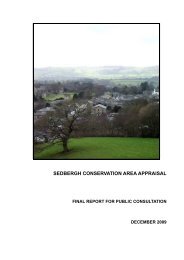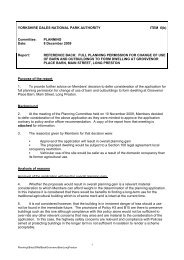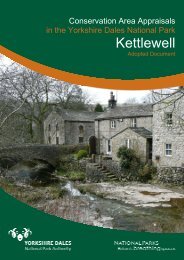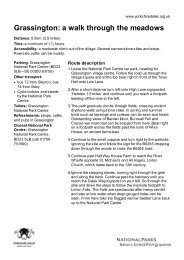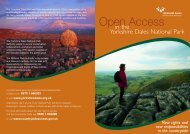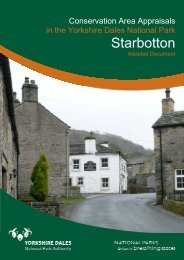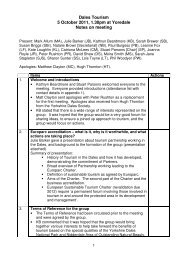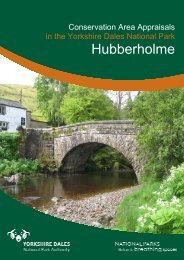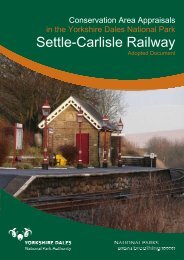Langcliffe - Yorkshire Dales National Park
Langcliffe - Yorkshire Dales National Park
Langcliffe - Yorkshire Dales National Park
- No tags were found...
Create successful ePaper yourself
Turn your PDF publications into a flip-book with our unique Google optimized e-Paper software.
12345Light, Jo (2000) ‘TheGeology of <strong>Langcliffe</strong> Parish’,http://www.langcliffe.net/Geology.html.Croll, Kate & Leigh, Joyce(2000) ‘The Timeline’,http://www.langcliffe.net/Timeline.html.Slater, Michael J (2009) ‘TheEarly History of <strong>Langcliffe</strong> inCraven’,http://www.langcliffe.net/Historyof<strong>Langcliffe</strong>.html.Slater, Nancy (2000) ‘ABackground to the SocialHistory of <strong>Langcliffe</strong>’,http://www.langcliffe.net/Background%20Social%20History.html.Slater, Michael J (2009)‘<strong>Langcliffe</strong> Manor: a shorthistory’, email to Gaby Roseon 23 October.There are no rocks of the Devonian period in <strong>Langcliffe</strong>, which lastedfrom 410 to 350 million years ago, as the Silurian rocks were thenprobably above sea level.The Lower Carboniferous period began around 350 million years ago,when sediments were laid down in a calm tropical marine environment. In<strong>Langcliffe</strong>, the exposed rocks of the Great Scar Limestone are aparticularly pure limestone, composed mainly of calcium carbonate andthe remains of corals, crinoids, foraminifera, algae and shell fish. Theyare light grey in colour and weather even paler, with obvious horizontalbedding planes and a well-developed system of joints, which are verticallines of weakness. Different layers display a rhythmic pattern from thechanging sea levels. In the parish, these immense deposits of Great ScarLimestone have resulted in massive features like high cliffs, scars andlimestone pavements. Caves with interconnecting passages and shaftsare also a common feature of this landscape.The geological succession then passes into the deltaic sediments of theYoredale Series. They show a typical rhythmic type of sedimentation witha gradual change from a marine to terrestrial environment.During a period of mountain building around 270 million years ago, thearea was again raised above sea level, and has mostly remained dry landsince that time. Only recent drift deposits from the last glacial period arefound on top of the Carboniferous beds.A more detailed description of the parish’s geology can be found on the<strong>Langcliffe</strong> website 1 .4.2 Historic Development and ArchaeologyThis section describes the origins, archaeology and historic developmentof the <strong>Langcliffe</strong> Conservation Area.a) Origins and Historic Development of the AreaOrigins. Worked bone found in excavations at Victoria Cave providessome of the earliest evidence for human activity in the <strong>Yorkshire</strong> <strong>Dales</strong>.There are earthworks indicative of late prehistoric and Romano-Britishsettlements in the <strong>Langcliffe</strong> parish, but no recorded finds or evidence forany pre-medieval settlement in the vicinity of the village.The following information has mainly been adapted from the <strong>Langcliffe</strong>website 2, 3, 4 , unless stated otherwise.Historic development. The village takes its name from the adjacentlimestone scars. The name is first mentioned in the Domesday Book of1086 as ‘Lanclif’. The parish of Giggleswick, in which <strong>Langcliffe</strong> lay beforeit became a parish of its own right in 1851, belonged at that time to RogerPoitou, although soon after the Percy family became its overlords. In1148, William de Percy founded the Cistercian Sawley Abbey on thebanks of the Ribble near Clitheroe, Lancashire.The Manor of <strong>Langcliffe</strong> was a territorial unit under feudal lordship,including arable and waste land, the village and further houses orfarmsteads 5 . Its development is closely tied to the histories of severallocal families.In 1221, Elias de Giggleswick, Lord of the Manor of <strong>Langcliffe</strong>, appealedto the Papal Legate about a corn mill built by the Cistercian monks ofFurness Abbey on his side of the river, taking away the custom from hisown mill. As a consequence, the monks had to hand the mill over. Inhope of buying salvation, Elias granted all his land in <strong>Langcliffe</strong> to SawleyAbbey in around 1240, making the abbot Lord of the Manor and14



